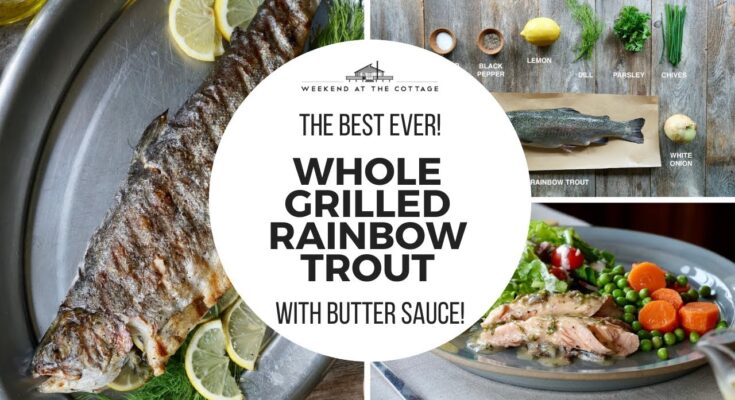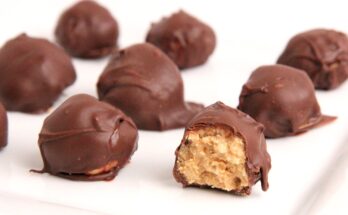Rainbow Trout Recipe: There’s nothing quite like the delicate, slightly nutty flavor of freshly cooked rainbow trout. Whether you caught it yourself or picked it up from a local market, cooking rainbow trout at home is a satisfying and delicious endeavor.
This step-by-step guide will walk you through everything you need—from selecting the freshest fish to seasoning it just right and mastering multiple cooking methods.
Perfect for both beginners and home-cooking pros, this is your go-to guide for preparing rainbow trout like a seasoned chef.
What Makes Rainbow Trout Special?
Rainbow trout isn’t just another fish on the menu. It stands out for its vibrant coloring, mild flavor, and versatility in cooking. What makes it truly special is its adaptability—you can bake it, grill it, or pan-fry it with ease. Plus, it’s one of the most beginner-friendly fish when it comes to preparation. No overpowering fishy taste here—just clean, rich, and tender meat that pairs beautifully with herbs, citrus, and a splash of olive oil.
Rainbow trout are freshwater fish, commonly found in North America, especially in cool, clear rivers and lakes. They’re part of the salmon family, which is why they have that characteristic pink flesh when cooked. What’s even better? You often find them available as whole fish, which is excellent for recipes that aim for presentation as well as taste.
If you’re someone who’s trying to add more fish to your diet or reduce red meat, rainbow trout is a brilliant choice. It’s less oily than salmon but still rich enough to satisfy your cravings. Plus, it’s usually more affordable, making it a staple in many kitchens.
Nutritional Value of Rainbow Trout
Here’s where rainbow trout truly shines. It’s packed with essential nutrients and lean protein, making it a healthy choice for almost any diet. One 3-ounce (85 grams) cooked serving contains approximately:
- 20 grams of protein
- Just 140 calories
- 5 grams of fat, most of which are healthy omega-3 fatty acids
- An impressive dose of vitamin B12
- Rich amounts of niacin, phosphorus, and selenium
The omega-3s found in trout help with heart health, reducing inflammation, and supporting brain function. And because it’s relatively low in mercury compared to many other fish, it’s considered safe to consume even a few times a week. If you’re on a keto, paleo, or Mediterranean diet, rainbow trout fits perfectly into your meal plan.
Ingredients You’ll Need
Freshness Matters – Choosing the Right Trout
First thing’s first—buying quality fish is non-negotiable. Look for trout that’s fresh, firm, and has a mild, clean smell. Avoid anything that smells too “fishy” or has discolored patches.
If you’re buying whole fish:
- The eyes should be clear and not sunken.
- The skin should be shiny, with vibrant scales.
- The gills should be reddish-pink, not brown or gray.
If you’re buying fillets:
- The flesh should be moist, not dry or curling at the edges.
- It should be slightly translucent, not dull or milky.
Frozen trout works too—just ensure it’s flash-frozen and properly sealed without any freezer burn.
Herbs, Spices, and Pantry Staples
Now to flavor. Here’s a basic list of ingredients that brings out the natural flavor of the fish without overpowering it:
Essential Ingredients:
- 2 whole rainbow trout (cleaned and gutted)
- 2 tablespoons olive oil or melted butter
- Salt and freshly ground black pepper
- 1 lemon (sliced)
- 2 cloves garlic (thinly sliced)
- A handful of fresh herbs (parsley, dill, thyme, or rosemary)
Optional Add-ons for Extra Flavor:
- Paprika for smokiness
- Red chili flakes for a touch of heat
- A splash of white wine or lemon juice
- Sliced onions or fennel for stuffing
These simple ingredients are enough to create a mouthwatering dish. The key is not to go overboard. Rainbow trout has a delicate flavor, and a minimalist approach often works best.
Kitchen Tools for Cooking Rainbow Trout
Must-Have Utensils
You don’t need a fully stocked kitchen to make an incredible trout dish, but a few tools will make the job much easier:
- Sharp knife – for gutting, filleting, or scoring the fish
- Cutting board – preferably one designated for raw meats
- Tongs or spatula – for flipping the fish gently
- Baking sheet or skillet – depending on your cooking method
- Fish scaler (if using whole, uncleaned fish)
These tools ensure you can handle the trout properly without damaging its delicate flesh. Plus, they make prep quicker and less messy.
Optional Tools That Help
If you’re looking to elevate your trout game, here are some optional kitchen tools that make the experience smoother:
- Fish basket (for grilling) – keeps the fish intact
- Meat thermometer – ensures perfect doneness (145°F/63°C internally)
- Zester or microplane – for adding lemon zest or garlic
- Roasting rack – helps the trout cook evenly in the oven
Whether you’re keeping it simple or going gourmet, the right tools make a big difference in achieving restaurant-quality results.
Preparing the Rainbow Trout
Cleaning and Gutting the Fish
If you bought your trout whole and uncleaned, it’s time to get your hands a little messy. Don’t worry—gutting and cleaning fish sounds scarier than it is.
Steps:
- Rinse the fish under cold water.
- Use a fish scaler or the back of a knife to remove scales—move from tail to head.
- Make a shallow incision from the anus up to the gills.
- Pull out the guts and discard.
- Rinse the cavity well and pat dry with paper towels.
If you prefer, most fishmongers will do this for you. But it’s always good to know how in case you’re dealing with freshly caught trout.
Marinating for Maximum Flavor
Rainbow trout doesn’t need a long marination time. A quick 15-30 minutes is more than enough. Here’s a simple yet flavorful marinade:
Quick Marinade:
- Olive oil
- Lemon juice and zest
- Chopped garlic
- Chopped fresh herbs
- Salt and pepper
Coat the inside and outside of the fish, stuff a few lemon slices and herbs into the cavity, and let it sit at room temperature while your oven or grill preheats. This step locks in moisture and adds complexity to the fish’s natural flavor.
Cooking Methods Explained
Oven-Baked Rainbow Trout
If you’re after simplicity with guaranteed deliciousness, baking rainbow trout is the way to go. It’s fuss-free, hands-off, and perfect for beginners. Plus, baking helps the fish retain its moisture while allowing the flavors of the marinade to seep in.
Step-by-step:
- Preheat your oven to 375°F (190°C).
- Prepare a baking dish lined with foil or parchment paper for easy cleanup.
- Place the cleaned and marinated fish in the dish. If using whole fish, stuff the cavity with herbs and lemon slices.
- Drizzle with olive oil or melted butter. Optionally, splash some white wine or lemon juice over the top for added moisture and flavor.
- Seal with foil (for moist fish) or leave open for a slightly crispier texture.
- Bake for 15–20 minutes, depending on the size of the fish. A good rule is 10 minutes per inch of thickness.
- Check doneness by inserting a fork into the thickest part. The flesh should flake easily and be opaque.
Serving tip: Serve with roasted vegetables, wild rice, or a crisp salad. You’ll be surprised how well this simple dish competes with restaurant-quality meals.
Pan-Fried Rainbow Trout
Pan-frying adds a crispy skin and golden exterior that many seafood lovers crave. It’s quick, flavorful, and great for weeknight dinners when you don’t want to wait on the oven.
Here’s how to do it:
- Heat 1–2 tablespoons of oil (canola, olive, or butter) in a non-stick or cast-iron skillet over medium heat.
- Pat the fish dry to prevent splatter and promote even browning.
- Season both sides with salt, pepper, and optional spices like paprika or cayenne.
- Lay the fish skin-side down in the pan.
- Cook for 3–5 minutes per side. Avoid flipping too soon—wait until the skin crisps up and the fish naturally releases from the pan.
- Flip carefully using a wide spatula. Cook the other side until golden and the flesh is cooked through.
Optional: Deglaze the pan with a splash of lemon juice, white wine, or broth for a quick pan sauce.
Pro Tip: If cooking fillets, press them gently with a spatula during the first minute to avoid curling.
Grilled Rainbow Trout (Optional)
If it’s grilling season and you want to impress guests, grilling rainbow trout over an open flame delivers a smoky, charred flavor that’s hard to beat. It’s also a fun way to cook outdoors and add a rustic vibe to your meal.
Here’s how:
- Preheat your grill to medium-high heat.
- Oil the grates well to prevent sticking.
- Brush the fish with olive oil and season inside and out.
- Place stuffed trout (with lemon and herbs) directly on the grill or use a fish basket for easier handling.
- Grill for 4–5 minutes per side depending on thickness.
- Use a spatula to check the bottom. If it lifts easily and has grill marks, it’s ready to flip.
- Once fully cooked, remove and serve with grilled veggies or a side of chimichurri.
Grilled rainbow trout is perfect for summer barbecues and pairs wonderfully with a cold beer or crisp white wine.
Serving Suggestions and Pairings
Simple Sides that Complement Trout
When you’ve cooked your trout to golden perfection, you want sides that elevate but don’t overpower it. Here are some winning combinations:
- Lemon herb rice – A fragrant, light starch that soaks up all the drippings.
- Garlic roasted potatoes – Crispy on the outside, soft inside.
- Steamed asparagus or green beans – Add a fresh crunch and color to your plate.
- Mixed greens salad – Drizzle with a vinaigrette for a tangy balance.
Pro tip: Use the leftover lemon and herb-infused pan juices as a dressing or drizzle.
Wine and Beverage Pairings
A nice drink can turn this meal into a five-star experience:
- White wines like Sauvignon Blanc, Pinot Grigio, or Chardonnay
- Sparkling wine for a celebratory meal
- Light beers like pilsners or wheat beers
- For non-alcoholic options: sparkling water with lemon, mint iced tea, or cucumber-lime spritz
Pairing drinks that are light and acidic will balance the rich, buttery texture of the trout beautifully.
Storing and Reheating Leftover Trout
How to Store Cooked Trout
Got leftovers? Rainbow trout holds up surprisingly well when stored properly.
- Let it cool to room temperature (don’t leave it out for more than 2 hours).
- Store in an airtight container or wrap tightly with foil/plastic wrap.
- Place in the refrigerator and consume within 2–3 days.
For longer storage:
- Wrap tightly in foil and place in a freezer-safe bag or container.
- Freeze for up to 2 months.
- Label with date and type to avoid freezer surprises.
Best Reheating Practices
You want to retain that tender texture—not dry it out.
In the oven:
- Preheat to 275°F (135°C).
- Add a splash of broth, lemon juice, or water to keep it moist.
- Cover with foil and warm for 10–15 minutes.
On the stovetop:
- Heat gently in a non-stick pan with a bit of butter or oil.
- Cover with a lid to steam and heat evenly.
Avoid microwaving if you can—it tends to dry out the fish and zap the flavor. If you must, add a bit of moisture and use the “reheat” setting or go low and slow.
Tips for Perfecting Your Rainbow Trout Recipe
Common Mistakes to Avoid
Even though rainbow trout is one of the easier fish to prepare, there are a few pitfalls that can take your dish from wow to meh.
- Overcooking the fish – This is hands down the most common mistake. Remember, fish continues to cook slightly even after it’s removed from the heat. Always aim for an internal temperature of 145°F (63°C), or stop just before and let residual heat finish the job.
- Not drying the fish before cooking – Moisture is the enemy of crispy skin. Pat the fish completely dry before seasoning and cooking.
- Over-seasoning – Rainbow trout has a naturally mild, sweet flavor. Don’t drown it in spices or heavy sauces. Stick to simple seasoning: salt, pepper, lemon, and herbs.
- Not preheating your pan or oven – Starting cold means your fish may cook unevenly or steam rather than sear.
- Forgetting to rest the fish – Letting your cooked fish sit for just 2-3 minutes before cutting allows the juices to redistribute, keeping it moist.
Avoiding these rookie errors ensures a succulent, flavorful dish every time.
Chef’s Secrets for Enhanced Flavor
Want to take your trout to the next level? Here are a few professional tips:
- Score the skin lightly before cooking to help it crisp up and prevent curling.
- Use compound butter (butter mixed with herbs, garlic, and zest) for basting.
- Toast spices like cumin or fennel seeds for a unique flavor twist.
- Add finishing salt or citrus zest just before serving for a burst of brightness.
- Rest your cooked fish on a bed of herbs or greens to absorb aromatics.
These small enhancements can transform a simple meal into a gourmet experience.
Health Benefits of Eating Rainbow Trout
Rainbow trout isn’t just delicious—it’s a nutritional powerhouse. It’s loaded with lean protein, omega-3 fatty acids, and a wide range of essential vitamins and minerals.
Why it’s great for your body:
- Heart Health: Omega-3s in trout reduce blood pressure, cholesterol, and inflammation.
- Brain Boost: Regular consumption supports brain function and may help delay age-related decline.
- Muscle Recovery: High protein content aids in muscle repair and development.
- Immune Support: Rich in selenium and B-vitamins, which enhance immune response and energy levels.
Plus, it’s low in mercury and safer than many larger fish like swordfish or tuna, especially for children and pregnant women. If you’re looking to clean up your diet, trout is a top-tier protein to work with.
Rainbow Trout for Special Diets
Rainbow trout is incredibly adaptable and fits into most dietary lifestyles.
For Keto and Low-Carb Dieters:
- Trout is zero-carb and high in healthy fats. Pair it with buttered veggies or cauliflower mash.
For Paleo Followers:
- Cook trout with ghee or olive oil, and serve with sweet potatoes or a fresh green salad.
For Gluten-Free Eaters:
- No problem—just avoid breading and use naturally gluten-free seasonings. A lemon herb rub or spice blend works wonders.
For Mediterranean Diet Fans:
- Trout is a Mediterranean staple. Serve with olives, cherry tomatoes, quinoa, and a drizzle of olive oil for a vibrant meal.
No matter your lifestyle, rainbow trout is a clean, wholesome protein source that easily fits your goals.
Rainbow Trout Recipe Variations
Tired of the same old lemon-and-herb combo? Let’s shake things up. Here are a few creative twists on the classic trout recipe:
1. Asian-Inspired Trout:
- Marinate with soy sauce, sesame oil, ginger, and garlic.
- Serve with rice and sautéed bok choy.
2. Cajun-Spiced Trout:
- Rub with Cajun seasoning and a touch of smoked paprika.
- Serve with corn on the cob and creamy coleslaw.
3. Mediterranean Trout:
- Stuff with olives, sun-dried tomatoes, red onion, and feta.
- Serve with couscous or grilled vegetables.
4. Trout en Papillote (In Parchment):
- Wrap trout with veggies, herbs, and lemon slices in parchment paper.
- Bake until puffed and steaming—healthy and mess-free!
5. Smoked Trout Spread:
- Use leftover cooked trout, cream cheese, lemon juice, and dill.
- Blend into a creamy spread for crackers or toast.
These variations keep things fresh and exciting, giving you new ways to enjoy this fantastic fish.
FAQs about Rainbow Trout Recipe
1. What is the best way to cook rainbow trout?
The best methods for cooking rainbow trout are baking, pan-frying, or grilling. Each method brings out the fish’s natural, delicate flavor without overpowering it.
2. Should I remove the skin from rainbow trout before cooking?
No, you don’t have to. The skin is thin and crisps up nicely when cooked, adding flavor and texture. Just make sure it’s properly cleaned.
3. Is rainbow trout healthy?
Yes! Rainbow trout is a lean source of protein, rich in omega-3 fatty acids, vitamins B12 and D, and low in mercury—making it a heart-healthy choice.
4. What flavors go well with rainbow trout?
Lemon, garlic, fresh herbs like dill and parsley, and a touch of butter complement the mild flavor of rainbow trout perfectly.
5. Can I cook rainbow trout from frozen?
Yes, but it’s best to thaw it first for even cooking. If you’re in a hurry, you can cook it from frozen—just allow a bit more time and adjust your seasoning.
6. How do I know when rainbow trout is fully cooked?
The flesh should be opaque and flake easily with a fork. The internal temperature should reach 145°F (63°C).
Conclusion
Cooking rainbow trout at home doesn’t need to be intimidating or fancy. It’s one of those dishes that rewards simplicity, yet offers so much room for creativity. Whether you bake, pan-fry, or grill it, the key is to respect the natural flavor of the fish and avoid overcomplicating things. With a few fresh herbs, a squeeze of lemon, and a hot skillet or oven, you’re already halfway to an unforgettable meal.
So the next time you’re staring at a rainbow trout in the market or freshly pulled one from the river—don’t hesitate. You now have all the tools and know-how to turn it into a healthy, flavorful, and impressive dish. Time to cook, eat, and enjoy!



